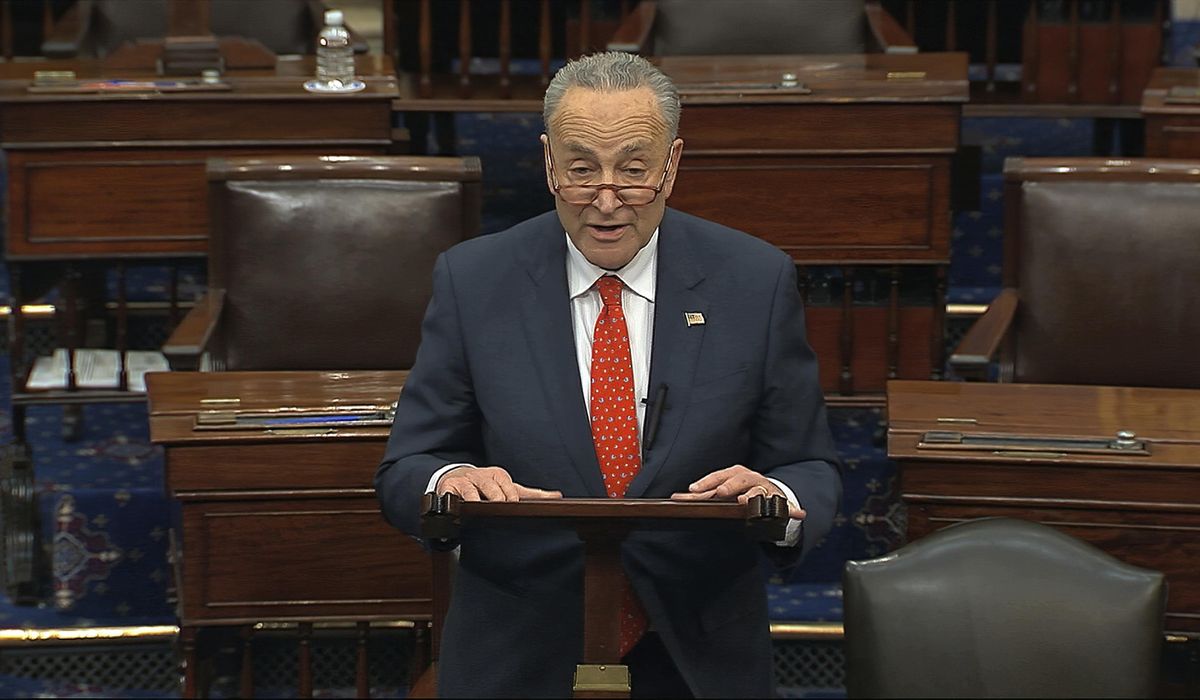
If Sen. Charles E. Schumer were still the minority leader, it’s a good bet that he would be using the filibuster enthusiastically to stop Republican priorities, not fighting to eliminate it.
The New York Democrat has had plenty of practice. During 23 years in the Senate, he has voted more than 500 times to sustain a filibuster, according to data compiled by GovTrack.
But Mr. Schumer, who once called curtailing the filibuster a “doomsday for democracy,” now says the centuries-old practice has outlived its use.
“We must adapt for the sake of our democracy,” he said in a speech from the chamber floor last week.
He’s not alone in changing his mind.
The 50 members of the Senate Democratic Caucus have voted a combined 15,579 times to sustain filibusters since 1989, according to GovTrack’s data. Now, most are backing Mr. Schumer’s attempt to sideline the practice.
The Senate’s 50 Republicans aren’t far behind Democrats, notching 14,389 combined votes to sustain filibusters. At the rate they are voting, Republican senators will take the overall lead this year.
Those numbers hint at a deeper reality about the filibuster: It has become less about serious policy disputes and time for debate, and more about partisanship. Senators use it when they are in the minority and bemoan its use when in the majority.
“If anything, the GovTrack data support a more obvious thesis about our politics: that senators increasingly play team ball. They vote with their party,” said Kevin Kosar, a congressional expert at the American Enterprise Institute.
Michael McKenna, a top legislative official in the Trump White House, said, “It’s a shirts and skins game. You vote for your team.”
The public seems to understand the bipartisan use of the filibuster better than some senators.
A TIPP Insights survey conducted last week found that 51% of Democrats and 53% of Republicans said filibusters were all right with them. The dissenting voice came from independents, with just 38% supporting the filibuster as an institution.
Filibustering doesn’t appear in the Constitution. It is a creation of the Senate, and the name was attached in the late 1800s to a long-standing practice of allowing a single senator the power to hinder business.
In the last century, Southern Democrats used the filibuster to block civil rights legislation, fueling a more modern attempt to label it as a tool of racism. Still, it’s tough to square that label with the more than 15,000 votes that current Democrats have cast.
Former President Barack Obama, who has labeled the filibuster a “Jim Crow relic,” was among those who used the tool during his time in the Senate, including to force changes to a Patriot Act renewal in 2005 and to block a Republican estate tax repeal and new abortion restrictions in 2006.
Republicans, who were in the majority then, are now in the minority. They are using the filibuster to block Democrats’ push to write new national rules governing elections and voting.
Mr. Schumer is trying to rally the 50 members of his caucus to use the “nuclear option” to change the filibuster rules, lessening the threshold for action to a mere majority of senators voting. He has set a deadline for Monday — Martin Luther King Jr. Day — for his next step, though he hasn’t revealed what it will be.
There is no firm yardstick for measuring how many filibusters have been launched over the years, partly because of different manifestations, including a single senator holding the floor or a group of senators vowing to block legislative progress.
Heading off a filibuster can be done through what is known as a cloture vote, which can be tallied. Every time a senator votes against cloture, it’s effectively a vote to sustain a filibuster.
That was the data GovTrack analyzed at the request of The Washington Times, using records from Aug. 2, 1989, up to this past weekend. That encompasses the entire careers of all but four current members: Democratic Sen. Patrick J. Leahy of Vermont and Republican Sens. Chuck Grassley of Iowa, Mitch McConnell of Kentucky and Richard C. Shelby of Alabama.
Of the 100 current senators, four have never voted to sustain a filibuster. All four are Democrats who took office a year ago, have never served under a Republican-led Senate and presumably haven’t found an issue that they needed to filibuster.
By contrast, three Republicans who took office last year and have served only under Democratic control have voted to sustain nearly every filibuster when they have the chance.
Mr. Shelby, who started as a Democrat then switched to the Republican Party, is the reigning filibuster king. He has notched 646 “No” votes on cloture motions but has voted for cloture 990 times, making his filibuster rate 41% of the time.
Democrats’ top filibusterer is Sen. Ron Wyden of Oregon, with 584 “No” votes on cloture. Mr. Schumer ranks third among Democrats with 516 filibuster votes.
Over the 31 years of GovTrack’s records, Democrats and Republicans have each held the Senate for about 16½ years.
Mr. McKenna, who also writes a column for The Times, said that explains the nearly even number of filibuster-sustaining votes cast by each party’s senators.
Indeed, when Republicans had control of the Senate just a couple of years ago, President Trump pushed for eliminating the filibuster.
A bipartisan coalition of senators wrote a letter in 2017 pushing back on Mr. Trump’s demand and begging to preserve the filibuster. More than 25 Democrats still in the Senate signed that letter. So did Kamala Harris before she became vice president.
Across the chamber, the average senator backs cloture — officially cutting off debate and moving to final action — about 64% of the time.
More centrists far exceed that.
Sen. Susan M. Collins, Maine Republican, has voted for cloture 85% of the time over her 25 years in the Senate. Sen. Joe Manchin III, West Virginia Democrat, is close behind at 81%. Sen. Kyrsten Sinema, Arizona Democrat, also ranks high at 74%, even though she has spent most of her Senate career in the minority party.
Mr. Manchin and Ms. Sinema are key figures in the current battle over the fate of the filibuster, with Mr. Schumer eying changes that would make voting rights legislation not subject to the supermajority rule the same way budget bills are exempt.
Ms. Sinema and Mr. Manchin have expressed wariness over those sorts of moves.
“I’m not for breaking the filibuster, but I am for making the place work better by changing the rules,” Mr. Manchin told reporters on Tuesday.
He said he would be open to alterations such as lowering the filibuster threshold to bring a bill to the floor but not ending the supermajority requirement for getting to final passage of legislation. He signaled that he wanted Republican buy-in on those changes rather than a partisan power play that Democratic leaders are pondering.
Mr. Kosar, at the American Enterprise Institute, said a voting rights carve-out would do nothing to solve the broader political dynamic where each party’s desire to win the majority trumps the challenge of governing.
“Rather, it would have the Senate further capitulate to polarization,” he said.








